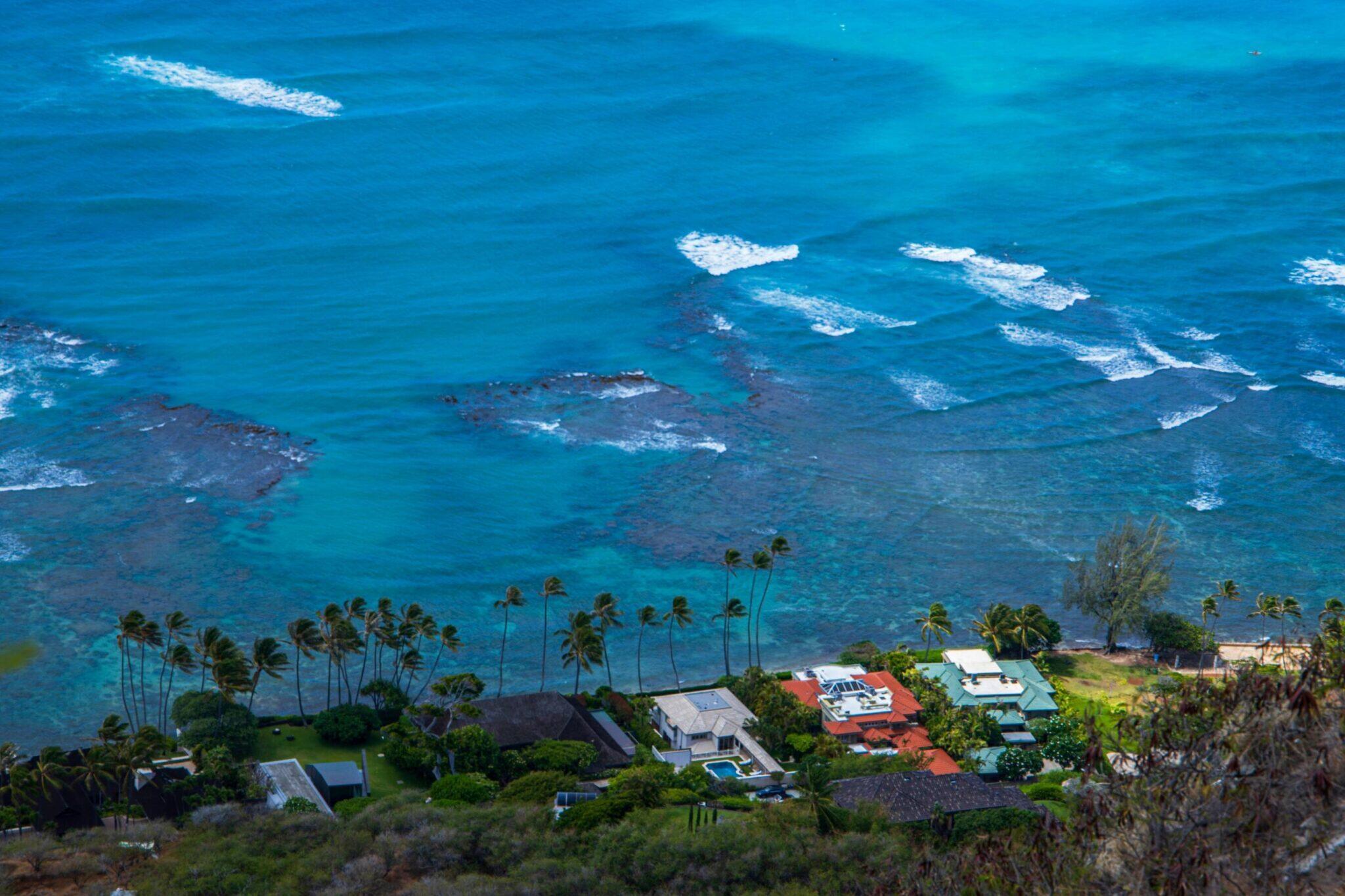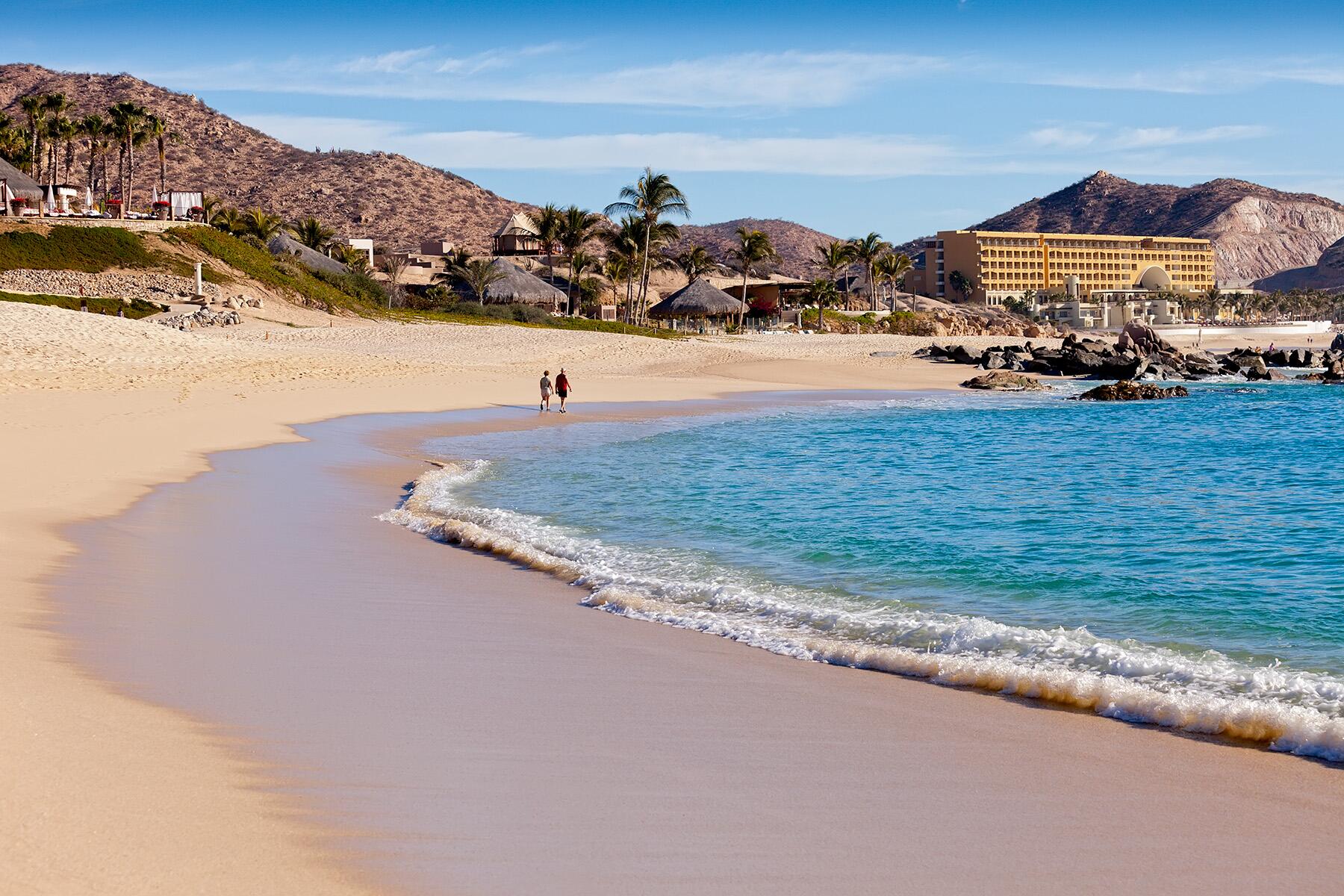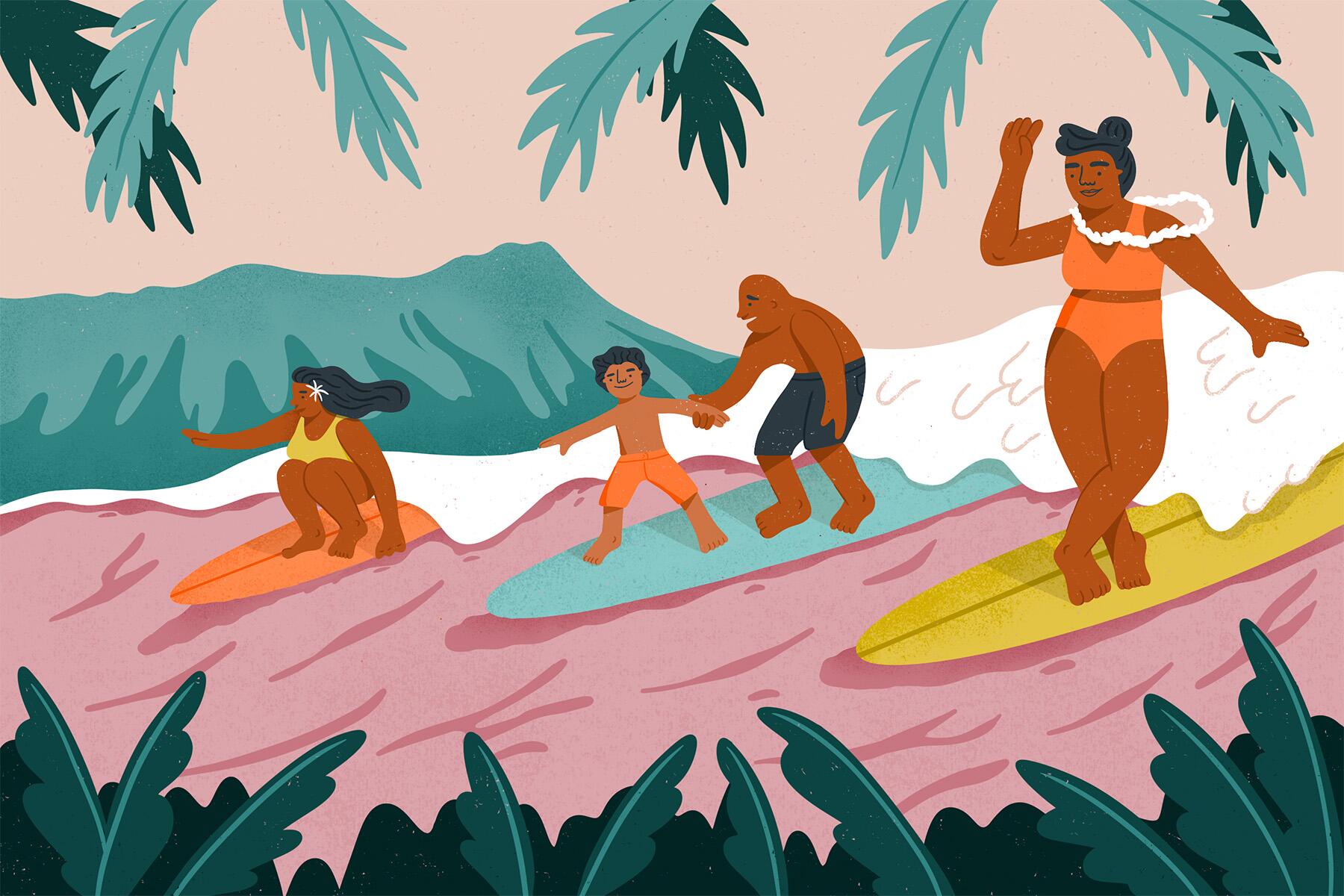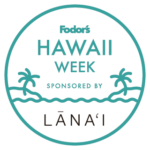If you’ve ever wanted to try your hand at surfing, Hawaii's world-famous Waikiki Beach is one of the best places in the world to get started.
Located on the south shore of Oahu, Waikiki is one of the most popular destinations in Hawaii. The neighborhood is known throughout the world for its two-mile-long stretch of white sand beaches, turquoise blue waters, and rolling waves that attract both local surfers and visitors who attempt to glide along the surf. These forgiving, playful waves make Waikiki the perfect place to learn the basics of surfing.
Surfing is much more than a sport or pastime in Hawaii. For many Native Hawaiians, like Tammy Moniz, it’s a way to connect with their ancestors’ heritage. She runs two surf schools with her husband, Tony, near the world-famous surf breaks on Waikiki Beach.
Tony Moniz grew up surfing in Waikiki as a child with his family. In the 1980s, he became a professional surfer and traveled the world competing, until he married Tammy and they started a family together. The pair decided to homeschool their children, allowing their family to spend their days together at the beach. Now the Moniz family has raised world-class surfers, including two-time world champion Kelia Moniz, and pro surfer Seth Moniz, who currently competes on the World Surf League tour.
Recommended Fodor’s Video
The husband and wife team runs Faith Surf School, where they’ve been teaching lessons for the last 20 years. In 2018, Billabong reached out to the Moniz family to open a surf school inside their Waikiki store, right across from Duke’s Statue. The family-run business would become Moniz Family Surf. Today, Moniz Family Surf embodies Hawaii’s rich surfing culture and history.
Before you try surfing, Tammy Moniz has a few things for you to consider to make the most of your experience.
You’re Practicing an Ancient Hawaiian Tradition
Surfing is more than just a sport to Native Hawaiians—it’s an important part of their cultural heritage. In Hawaii, surfing is known as the Sport of Kings. That’s because, in ancient Hawaii, surfing was deeply ingrained in the royal culture. The Hawaiian ali’i, or royalty, participated in the art of riding waves for centuries, using surfboards that were shaped from wood and ranged from 14-16 feet long.
“It’s said that the kings and queens would train for and compete in contests to determine who had the best ability to surf,” explains Moniz. Today, you can take surf lessons and ride on the same waves where Hawaiian royalty once surfed in Waikiki. It’s one of the best ways to experience Hawaiian culture and carry on their legacy of surfing, says Moniz.

You’re Never Too Old to Start Surfing
Maybe you have kids who want to try surfing on your next trip to Hawaii, but you’re not sure if they’re old enough. Or perhaps you want to go surfing but are worried that you’re too old to learn. Rest assured, there’s no age limit on when you can try surfing. For the most part, Moniz Family Surf works with students between the ages of 9 and 50. But Moniz has taught lessons with students whose ages range from 5 years old to 76!
One of the reasons why Waikiki is the perfect place for beginners of any age to take a surfing lesson is its gentle, slow-breaking waves. “Waikiki is the best place to learn how to surf and progress. As far as the wave, the amount of power it generates, how long it is, and how playful it is,” she says.
Waikiki Beach Is the Home of Surfing
California and Australia are widely known as world-class surfing destinations. What many don’t realize is that Hawaiian Duke Kahanamoku is credited with introducing the sport to both places. Considered the father of modern surfing, Kahanamoku also won 5 Olympic medals as part of the U.S swim team.
During his travels, Kahanamoku built surfboards from wood and gave demonstrations to crowds on the beaches. “The first surf lessons that were given outside of Hawaii came from Waikiki. There’s a very deep legacy and history in Australia and California, especially Australia, where they’re very proud of it. But it comes from Waikiki,” shares Moniz.
INSIDER TIPMoniz Family Surf is located inside of the Billabong store off Kalakaua Ave, which runs alongside Waikiki Beach. In front of the famous surf break, visitors can stop by the legendary statue of Duke Kahanamoku, known as “Duke’s Statue.”
View this post on Instagram
You Should Know How to Swim
While you don’t have to be an expert swimmer, basic swimming skills are key. “The better swimmer you are, the easier surfing is, and the less fearful it will feel because you’re not afraid to go underwater,” says Moniz. Her surf schools require the ability to swim comfortably across the small end of the pool before taking a lesson.
As fun as surfing is, children need to be comfortable with getting their heads in the water first. “The moment they go on a board, if they can’t swim, they don’t want to fall. And falling is a part of surfing—it can traumatize a child.” If they’re too scared, she recommends skipping the lesson altogether. A bad experience could ruin their whole perspective of the ocean. In this case, it’s better to keep the ocean a happy place for kids to play in the shoreline and build sandcastles, Moniz says.
It’s Easier to Learn on Bigger Surfboards
Longboards are a beginner surfer’s best friend. They traditionally range from 9 to 12 feet long and 20 to 24 inches wide, compared to a standard 6-foot shortboard. If you’re renting a board on your own, Moniz advises paying attention to the length. Beginner surfers are often tempted to choose a board based on how it looks, she says. The only problem is they might end up renting a board that’s too short to use.
“You’ll rent the prettiest, most colorful board, but you’ll take it out and can’t paddle it. Or it’s too small to catch any waves.” Overall, the success rate of being able to stand up and balance on the board is much higher when you’re riding a longboard. Surf schools typically use longboards because the extra surface area makes it much easier to paddle into a wave, catch it, and stand up.
View this post on Instagram
You Can Have Fun Even on the Smallest Waves
Waikiki is a magical place. The tropical waters are warm and, for the most part, there are rideable waves all year long. While the waves are most consistent during summer, you can still have a blast when the surf is small if you have the right mindset and equipment. Even on the smallest days, there are still little bumps you can catch to get the feel of it, Moniz says. “We may have to cancel lessons maybe two or three times a year because there are no waves. We rarely do that because there’s always something small they can catch.”
Surfing in Hawaii Is the Perfect Adventure
If you’re going to try surfing once in your life, Waikiki is the place to do it. Moniz suggests that parents who are signing up their children also consider joining the lesson themselves. The richness of the experience goes deeper than just how you spend one day on vacation—it’s about history, she says. “I’ve convinced many moms to do it. They’re so happy at the end.”
When you learn to surf in Hawaii, you’re surrounded by tropical scenery, iconic waves, and a rich history that dates back centuries. Plus, you get a chance to experience the ultimate island lifestyle!
Sharks in Waikiki Are Very Rare
A common fear among beginner surfers is the presence of sharks in the waters. The reality is, there’s always a possibility that you’ll encounter sharks when you’re in the ocean. But if you look at the numbers, shark attacks are incredibly rare. Annually, less than 100 shark bites are reported worldwide and there has never been a confirmed shark bite in Waikiki.
This is due to a large number of people in the area, but also the lack of marine life in the sea. “You go to Australia and there is more life in the water. In Waikiki, there’s not a lot of fish in the water so the sharks don’t come in very often,” said Moniz.
INSIDER TIPYou’re more likely to encounter green sea turtles, or honu, in the waters along Hawaii’s coast. Just don’t touch them! Hawaiian green sea turtles are endangered and therefore protected by law.
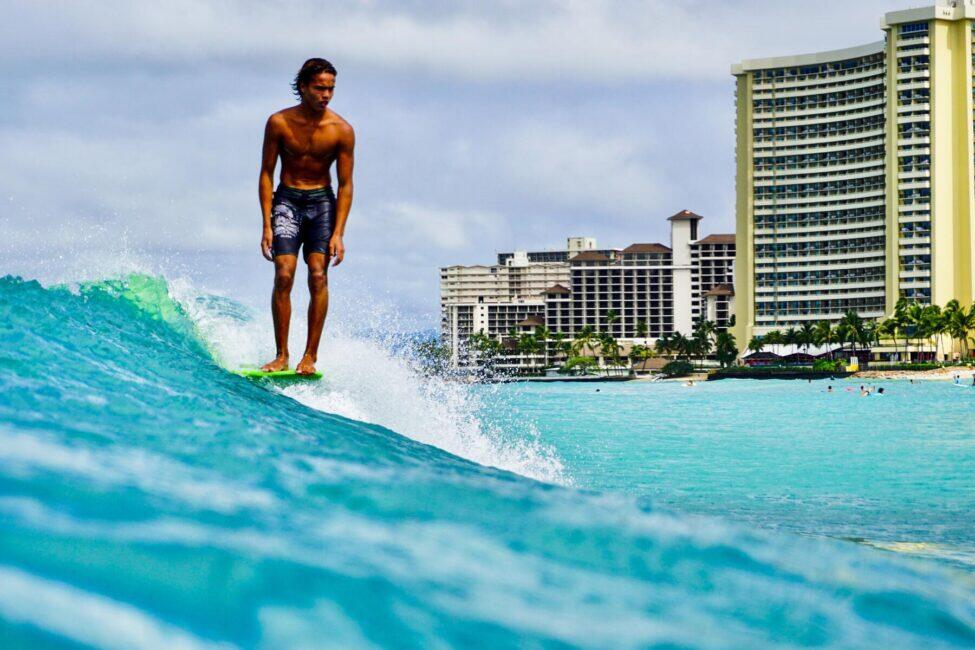
Surfing Lessons Are Worth It
The hardest part of catching a wave is being in the right place. That’s why Moniz suggests every new surfer takes a lesson. With an instructor, you’ll catch more waves because all you have to focus on is standing up. “You don’t have to worry about reading the waves, paddling for your life, and missing them,” she explains. Not only are lessons more fun for first-timers, but they’re also safer than going alone. You’ll have dozens of other surfers surrounding you in Waikiki, which can be overwhelming if you’re inexperienced.
“People still rent the boards, they go out, and some do okay with it. But it will always be worth doing a lesson. If you’re here for 5 days and want to surf, save your money and do a lesson every time you surf. Because you’re going to get way more waves, longer waves, and more practice on getting up.”
Editor’s Note: Per the Hawaii Tourism Board, Fodor’s recognizes “the proper use of the Hawaiian language, ‘Ōlelo Hawai‘i,’ which includes the ‘okina [‘], a consonant, and the kahakō [ō] or macron.” The Hawai‘i Board on Geographic Names was created to “assure uniformity and standardize spelling of geographic names to communicate unambiguously about places, reducing the potential for confusion.” In order to ensure our readers the best experience reading our Hawaii travel guides, we follow the standardized spelling, but hope to expose readers to the importance and cultural significance of the written Ōlelo Hawai‘i language.
